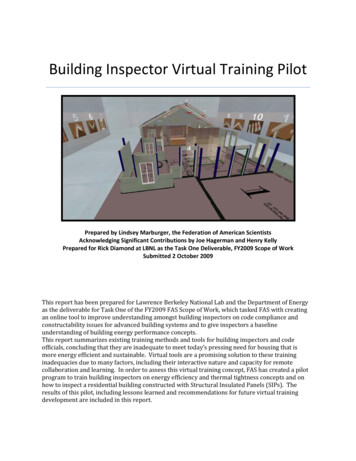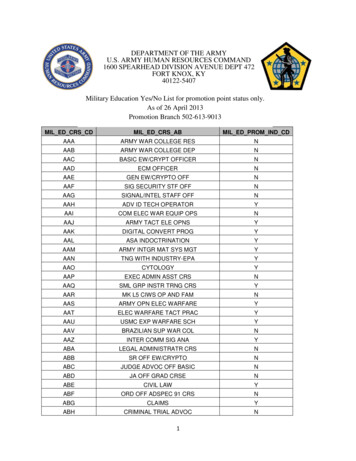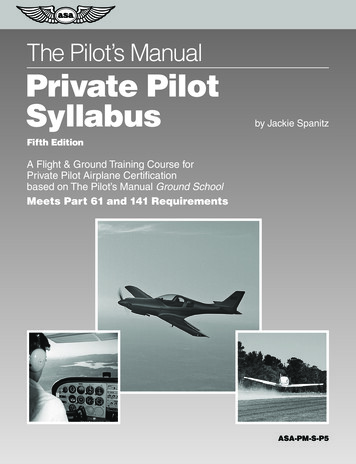
Transcription
Building Inspector Virtual Training PilotPrepared by Lindsey Marburger, the Federation of American ScientistsAcknowledging Significant Contributions by Joe Hagerman and Henry KellyPrepared for Rick Diamond at LBNL as the Task One Deliverable, FY2009 Scope of WorkSubmitted 2 October 2009This report has been prepared for Lawrence Berkeley National Lab and the Department of Energyas the deliverable for Task One of the FY2009 FAS Scope of Work, which tasked FAS with creatingan online tool to improve understanding amongst building inspectors on code compliance andconstructability issues for advanced building systems and to give inspectors a baselineunderstanding of building energy performance concepts.This report summarizes existing training methods and tools for building inspectors and codeofficials, concluding that they are inadequate to meet today’s pressing need for housing that ismore energy efficient and sustainable. Virtual tools are a promising solution to these traininginadequacies due to many factors, including their interactive nature and capacity for remotecollaboration and learning. In order to assess this virtual training concept, FAS has created a pilotprogram to train building inspectors on energy efficiency and thermal tightness concepts and onhow to inspect a residential building constructed with Structural Insulated Panels (SIPs). Theresults of this pilot, including lessons learned and recommendations for future virtual trainingdevelopment are included in this report.
ContentsTable of Figures . 2Introduction and Explanation of Training Gap . 3Current Industry Training Methods. 4Virtual Worlds and Web 2.0 . 5Current State of Virtual World Industry and Development . 5Second Life . 6Virtual World Adoption Barriers. 7Medulla. 8The Building Inspector SIP Training Module Pilot . 8Summary of Training Module Functions and Components. 9Advantages of this Virtual World and Web Training Pilot . 11Lessons Learned from Creating Building Inspector Training Module . 12Building in the Virtual World. 12New User Orientation . 12Virtual World Content. 12Recommendations and Next Steps for Virtual Training . 13Conclusion . 15Works Cited. 16Appendixes . 17Table of FiguresFigure 1. Introduction and Orientation Scene: billboard, presentation, and SIP models . 9Figure 2. Training House Scene: Training House and Gallery . 10Figure 3. Assessment House Scene . 112
Introduction and Explanation of Training GapWith the building sector using more energy and more electricity than any other sector in the UnitedStates, 1 this sector must become vastly more energy efficient and sustainable if the nation is to reach itscarbon reduction goals. In 2008, the residential building sector alone was responsible for almost 22% ofthe nation’s total energy consumption. 2 Through both retrofits of existing houses and through buildingmore efficient new houses, there is great opportunity and potential for energy savings within thebuilding sector. However, achieving these energy savings will require utilizing advanced technologies,materials, and systems that increase building envelope tightness, waste less energy, and improvebuilding comfort and security for occupants.One of the key barriers to the wide-scale adoption of energy efficient, high performing materials,practices, and technologies is a lack of education and training. Professionals and tradesmen often donot know to design with, install, or inspect these advanced materials and technologies, which thereforeare infrequently used and when utilized, do not perform optimally due to installation errors. In order tofacilitate their adoption and take advantage of the capabilities of these advanced products, trainingmust be improved throughout the industry; without this improved training they will neither achievesignificant market penetration nor achieve their energy efficiency potential.The Federation of American Scientists has worked closely with manufacturers of and industryprofessionals who work with structural insulated panels (SIPs), a high performing and energy efficientbuilding system. SIPs can be used for walls, flooring, and roofing and serve as an insulator, structuralsupport, and weatherproof barrier; they are structurally strong, have high thermal resistance whenproperly installed, produce little waste as they are manufactured and cut in the manufacturing plant,and are installed quickly and with fewer labor hours than a traditional stick framed structure. Despitepossessing these many positive attributes, market uptake of SIPs has been minimal. Manufacturers andrepresentatives of the Structural Insulated Panel Association (SIPA) note that building inspectors andcode officials are frequently neither familiar with SIPs inclusion in the International Residential Code(IRC) 3 nor inspecting SIPs for proper installation. In order for SIPs to be widely adopted by the buildingindustry and in order to ensure that code compliant and efficient installation occurs, improved SIPtraining tools for building inspectors are needed.1Architecture 2030 estimates that in 2000 the building sector (including residential, commercial, andmanufacturing buildings) was estimated to account for 48% of the nation’s energy consumption and 76% of theelectricity consumption.Architecture 2030, “The Building Sector: A Hidden Culprit,”http://architecture2030.org/current situation/building sector.html (accessed September 28, 2009).2Energy Information Administration, “Table 2.1a: Energy Consumption by Sector, 1949-2008,” Annual EnergyReview 2008, http://www.eia.doe.gov/emeu/aer/contents.html (accessed September 28, 2009).3SIPS are included in the 2009 International Residential Code, Section R613.International Code Council, 2009 International Residential Code For One- And Two- Family Dwellings, (USA:International Code Council, Inc., 2009), 348-356.3
Current Industry Training MethodsThe International Code Council (ICC), American Society for Heating, Refrigerating and Air ConditioningEngineers (ASHRAE), American Society of Home Inspectors (ASHI), National Association of HomeInspectors (NAHI), Institute for Building Technology and Safety (IBTS), and private and state/municipaltraining organizations all offer building inspector courses to train potential and current inspectors onunderstanding and inspecting for code compliant building practices. And while numerous organizationsoffer training programs, certification to become a certified building official (CBO) can only be given byeither the municipal/state government or one of the major CBO organizations, such as the ICC orASHRAE. These two organizations, in addition to certifying CBOs and holding certification exams, alsooffer courses that train building officials either to pass the exam or for the purpose of continuingeducation. Most of courses and seminars offered take place primarily in the classroom and emphasize aformat of instructor lectures and student memorization of key codes and code concepts. In theclassroom instructors use tools such as code books, written materials, and media such as videos and CDsto aid students in learning content.In addition to classroom time, many courses include time in the field (usually no more than one day)learning how to do an inspection from an experienced instructor. Courses taken in order to prepare fora certification exam, such as the ICC's Residential Building Inspector certificate exam, almost alwaysinclude both the classroom and field elements as students must both pass a written examination and afield examination, thereby proving both their knowledge of codes and related concepts and their abilityto actually perform an inspection. In recent years both the ICC and ASHRAE have begun to offer onlinetraining courses as an alternative to the physical classroom; these courses are referred to by the ICCas eTraining or as ICC Online Campus courses and by ASHRAE as eLearning courses. 4These instructor-led online courses or “webinars” cover nearly identical content to and follow a nearlyidentical format to the non-web courses, with an instructor lecturing and teaching to students via videostreaming and the students interacting with their instructor and asking questions in the online trainingenvironment. In addition, students can take independent online training courses; these courses consistof reading a section of the code or an explanation of an important concept, then answering problemsolving-style questions that utilize graphs, charts, and other media related to code concepts. Full-lengthweb-based practice exams are also offered to assist in reviewing course material. Collectively, theexisting web education capabilities consist of virtual lectures and seminars; making written materialsavailable, including code sections and summaries; online practice exams; and online independentcourses that educate students about codes and code concepts through limited interactivity, writtenmaterial, and media (i.e. videos, photos, and interactive charts and graphs).However, very little of the virtual content actually prepares students to be building inspectors. They arenot shown how to do a walk through; they are not able to practice comparing actual construction tostructural and architectural plans; they cannot simulate interacting with the parties involved in aninspection; and the interactive features are in reality little more than a picture or graph that, whenclicked, pops up a one sentence explanation of the content. And while webinars allow the instructorand students to verbally communicate and the students can see the instructor via video feed, theinstructor cannot simulate an inspection or show the details or plans being discussed, and theopportunity for social interaction is highly limited. Moreover, the training structure is almost entirely4International Code Council, “ICC Campus Online,” http://www.icccampus.org/ (accessed September 28, 2009).American Society of Heating, Refrigerating and Air-Conditioning Engineers, “ASHRAE eLearning,”http://www.ashrae-elearning.org/ (accessed September 28, 2009).4
based on verbal and written memorization and regurgitation, with little opportunity for kinestheticlearning and little thought given to improving the understanding and application of knowledge byencouraging transfer i.To develop a workforce of inspectors who understand both the need for energy efficient advancedtechnologies and how the code applies to energy efficient technologies and materials, training needs tobe more interactive, provide opportunities for kinesthetic learning, promote transfer, transcendgeographical limitations, and be structured as an integrated program that weaves together writtencurriculum content and field exercises and training.Virtual Worlds and Web 2.0The tools of web 2.0 and the latest iterations of virtual worlds possess the capabilities to carry outadvanced, remote, and highly interactive simulations, trainings courses, and educational seminars anddemonstrations needed by the building industry.Current State of Virtual World Industry and DevelopmentEstimates by Gartner, an information technology research consultancy, project that by 2011 80% ofactive internet users will have a virtual world avatar in some virtual world. This represents a significantmarket penetration rate and signifies that by utilizing virtual worlds, trainers and educators will not beintroducing students to an unknown technology, but rather introducing new content through a knownand understood medium. 5 This medium has been used by both the corporate and education worlds tohold meetings, conferences, and classes, to collectively work on projects and bring together expertsfrom different places, and to network and socialize. At Harvard University, for example, students canearn credit for a course attended in a virtual classroom. And at Intel, conferences and meetings areoften held at the virtual Second Life conference room. Research by the Palo Alto Research Centerindicates that group interactions and teamwork, psychological responses, and learning within theSecond Life world closely mirror that in the real world; as such, training and simulation modules that aredesigned to be interactive, hands-on, and mimic real-life scenarios can yield mental retention andlearning similar or even equivalent to that of the real-life scenario.To assess this theory and the value of virtual worlds in training adults to master complex skills, content,and scenarios, medical schools and health care facilities have begun to utilize virtual worlds as state-ofthe-art, interactive, and highly realistic training environments.The Imperial College London, for example, has built a virtual hospital in Second Life. The hospitalincludes a virtual operating room, where students practice treating patients and dealing with commonemergencies and operations, and a Virtual Respiratory Ward, where students test their knowledge ofrespiratory problems by interviewing, diagnosing, and recommending treatment for patients. While themedical field has used simulations for years via dummy operating and treatment rooms and softwarebased SIMs, early adopters note that the primary advantages of virtual world clinical training are: theability to bring geographically distant people together for the simulation, the low cost, and the ability tosimulate otherwise impossible or unsafe situations. In using a virtual world, training programs can bringexperts from around the world into one clinic to teach students and lead post-op discussions, while5Garnter Inc., “Gartner Says 80 Percent of Active Internet Users Will Have A "Second Life" in the Virtual World bythe End of 2011,” http://www.gartner.com/it/page.jsp?id 503861 (accessed 28 September 2009).5
allowing students to network and discuss their work, all at a much lower cost than bringing all partiesinto the same physical clinic. Scott Diener of the University of Auckland notes that “We tested [thevirtual O.R.] in a controlled experiment on 40 first-year medical students prior to their first visit to a realO.R. We wanted to determine if [the SL program] gives them more confidence before their firstexposure to the real thing. We’ve found it is just as effective as the training O.R. in the physical world.” 6Diener also emphasizes that virtual world simulations can expose students to situations that a standardacademic program cannot duplicate: “[SL] is not about creating an automated teaching environment. It’sabout giving students experiences we can’t give them otherwise, because it’s impossible or unsafe.” 7Thus, while there is not a great deal of empirical evidence as to the effectiveness of Second Life as atraining platform, initial studies by medical schools indicate that there are advantages to using virtualworlds over both classroom instruction and physical simulation in terms of the convergence of low cost,access to experts, and scenario-based simulation. 8The virtual world environment is currently the only means by which to bring people together in aninteractive environment without necessitating any physical travel. This capability, one of the mostimportant, reduces training expenses as building a virtual world simulation and putting participants inthat scene costs a fraction of what it costs to build a real world simulation and transport participants tothe site. Within the immersive environment participants can network, socially interact both verbally andface to face (or rather avatar to avatar) and can work together to solve problems or simulate real-lifescenarios, just as they would be able to in the real world. 9In terms of the building industry, potential simulations could include participants building or designinghousing components or entire houses as a team, being shown new technologies and techniques byindustry experts, reviewing or assessing a built structure, or inspecting the structural problems that ledto the destruction of a virtual building in a post-disaster simulation scenario. And as peopleintellectually and emotionally react similarly in both the physical and virtual worlds, the virtual worldcan be effectively used to familiarize students with concepts, places, and situations they will encounterin the field, but have never previously experienced. As a result, in the physical world the learning curveis shortened and problems encountered can be dealt with not as new experiences, but as previouslyencountered and solved problems.Second LifeSecond Life specifically is a useful training environment as it is currently the largest and mostcomprehensive virtual world. From building objects and avatar interactions to modeling energy orwater flows, leakage, and thermal resistance, Second Life is at this point the world wherein the mostadvanced and realistic whole building modeling and simulation can be done. In addition, under thetraining model currently employed by ASHRAE and the ICC participants pay to take both courses and totake the certification exams; with Second Life Grid platform and Second Life Work (the version of6Melissa Lafsky, “Can Training in Second Life Teach Doctors to Save Real Lives?” Discover Magazine secondlife (accessed September 28, 2009).7Ibid.8Citation from Sachin on scenario-based learning9Greg Wadley and Nicolas Ducheneaut, “The 'out-of-avatar experience': object-focused collaboration in SecondLife,” (paper presented at the European Conference on Computer-Supported Cooperative Work, Vienna, Austria,September 7-11, 2009), c/ECSCW09-WadleyDucheneaut.pdf(accessed September 28, 2009).6
Second Life targeted toward corporate, government, and education users) training organizations neednot alter their revenue model as the professional edition allows owner to keep their property andcontent behind a password protected firewall. Though the behind-the-firewall option is currently inbeta form, it will allow property owners to limit access to all or part their properties, thereby allowing atraining space to be accessible only to registered users for a specific period of time. For example, insigning up and paying for a building inspector course trainees would be paying for access to a particulartraining environment for a set period of time (such as 90 days) in order to participate in the formaltraining course, then continue to use that same environment to practice and enhance the skills andknowledge learned from the instructor.Virtual World Adoption BarriersThere are key issues that at the present time inhibit the large-scale adoption of virtual worlds as a toolfor business and education. The primary problem is the lack of interoperability and compatibilitybetween virtual worlds. An object built in Second Life, for example, cannot be exported into anotherworld and vice versa; with different coding languages and data formats, despite the open source natureof coding languages (referred to as Linden Scripting Language in Second Life), content and language canonly be shared within that limited world. Industry analysts therefore recommend against making hugemonetary investments in virtual worlds until such a point that the various platforms are compatible.However, while large-scale investment in one platform for commercial purposes is unwise until such apoint that virtual worlds are compatible or integrated, this logic does not as readily apply to education.For the purposes of education and training, the cost savings of training in a virtual world environment isimmediate and ongoing and the objective is to use the environment as a tool for educating and trainingan audience acquired through non-virtual means rather than to meet the commercial objective ofpromoting a product or brand image to potential customers encountered within the virtual world.A second barrier to virtual world business and education adoption lies in that each user must haveInternet access, computer access, and basic familiarity with operating within the virtual world as well asits functions and capabilities. Without reliable Internet and computer access, participants cannot takeadvantage of any virtual world training and without a basic virtual world familiarity, participants mustundergo an additional orientation and adjustment period while learning how to operate and function ina virtual world. The necessity of learning these new virtual world skills in addition to the course contentmay deter some potential participants from utilizing this new training platform. However, according tothe 2009 Digital Future Report by the Center for the Digital Future, over 80% of people in the UnitedStates now use the Internet and only 15% of homes do not have a computer. Of the Internet users, over80% connect have a Broadband Internet connection. 10 Thus, lack of reliable Internet and a computer isbecoming increasingly less of a barrier. When these figures are coupled with the estimate by theGartner Group that 80% of Internet users will have a presence in non-gaming virtual worlds by 2011, it isapparent that the majority of the working age American population has familiarity with the Internet andat least a basic familiarity with virtual worlds that will rapidly grow over the coming years. 1110Center for the Digital Future, “Digital Future Project Release Highlights,” 2009,http://www.digitalcenter.org/pdf/2009 Digital Future Project Release Highlights.pdf (accessed September 28,2009).11Anders Gronstedt, “Virtual World Learning,” Training Magazine t aa(accessed September 28, 2009).Anders Gronstedt, “Training in Virtual Worlds,” Training Technology and E-Learning, Iss. 0803 (2008).7
At present, there is no simple mechanism by which to connect virtual worlds to outside resources anddata. Objects can be linked to outside web sites, but creating a library of information, supportingresources, media, learning activities, and assessments, then gathering all of that content into oneorganized, easy to understand location is not possible in the virtual world. This ability to organize andlink materials and content to the virtual world is a necessary feature for most trainers and educators asthe simulation in the virtual world is not a stand alone, but a key component of a larger curriculum. Inthe case of training building inspectors, the virtual scenarios and instructor-led sessions are acomponent of a course that needs numerous components to be effective, including materials such asexam preparation documents, practice exams, and code books, and tools such as media, discussionforums, architectural CAD images and structural and engineering drawings.As such, in order for virtual worlds to become an effective and widely used learning environment, theymust be integrated with a simple, user-friendly platform with features including, but not limited to:materials storage and organization, curriculum and content explanations, wiki and forum integration,and assessments and assessment results storage. Through integration of such a platform with virtualworld training environments a truly interactive, immersive, innovative education and training tool canbe created.MedullaIn order to solve the issue of the inability to easily integrate virtual worlds with outside resources anddata, the FAS has created Medulla, an independent platform that weaves together virtual worlds andweb tools. The purpose of Medulla is to allow:a. collaboration among users across virtual worlds, Medulla tools, and third-party tools includingcommercial web applications;b. interoperation between two independently hosted web applications irrespective of theirinternal composition; andc. creation and archiving of content in virtual worlds that is viewable and searchable on the web(for further details on the functionality and purpose of Medulla, see Appendix 1).Specifically, Medulla weaves together tools such as digital archives (DSpace), wikis, virtual worlds, anddigital media such as videos and photos and organizes them in an open source, easy to navigatetemplate. This template allows the project manager to tailor the template for the target audience,writing descriptions and learning objectives for the training module as a whole as well as individualscenes and objects within the immersive training environment; link each template (including its writtencontent and supporting materials) to a virtual world or multiple virtual world scenes; create and postlearning activities and scenario guides; and organize references, media, learning activities, andsupporting materials into categorized group boxes. In addition, all registered users can upload files tothe group boxes and edit the project’s wikis, allowing users to learn form and contribute to aninteractive and constantly evolving project that works with and within the virtual world and gathers thecurriculum and learning content into one simple template.The Building Inspector SIP Training Module PilotUtilizing the Second Life virtual world and the Medulla web platform, FAS has created a pilot project totest the feasibility of training building inspectors in the virtual world. The specific goals of this projectare to ease the adoption of advanced building technologies and to improve training related to energyefficient construction and advanced technology in the construction industry. The pilot also seeks toimprove understanding of code compliance and constructability issues among building inspectors and8
code officials. More broadly, this pilot seeks to teach residential building inspectors how to properlyinspect a home built with SIPs by educating and then assessing the trainee on code compliance issueswith SIPs, common installation errors, and energy efficiency concepts. A highly flexible training tool, thevirtual world environment can be used in formal instruction, to independently learn practice inspecting,to expand conceptual knowledge of energy efficiency and SIP concepts, and for self-assessment. Assuch, virtual world space has been designed with the goal of providing an intuitive and interactivelearning environment that is highly flexible and connected to relevant, engaging, and educationalmaterials and media.Summary of Training Module Functions and ComponentsIn this module, the SIP training and assessment primarily occurs within the Second Life virtual world,with additional content, supporting material, and training tools hosted on Medulla. Key topics coveredby Medulla content include: the purpose and goals of the training module; background on how Medullaand Second Life work and interact; how to function within the Second Life world; the capabilities of thetraining environment and virtual world; scenarios for independent and instructor led education; skillsthat the trainee will acquire; information on SIPs and constructing and inspecting SIP houses; anddetailed data about key components of SIP architecture and engineering. This information is providedto users by through a variety of mediums, including text, images, architectural and structural drawings,video, and models of real and virtual SIP structures.The Building Inspector SIP training area is broken into three primary components: the Introduction andOrientation area, the Training House
active internet users will have a virtual world avatar in some virtual world. This represents a significant market penetration rate and signifies that by utilizing virtual worlds, trainers and educators will not be introducing students to an unknown technology, but rather introducing new content through a known and understood medium .










